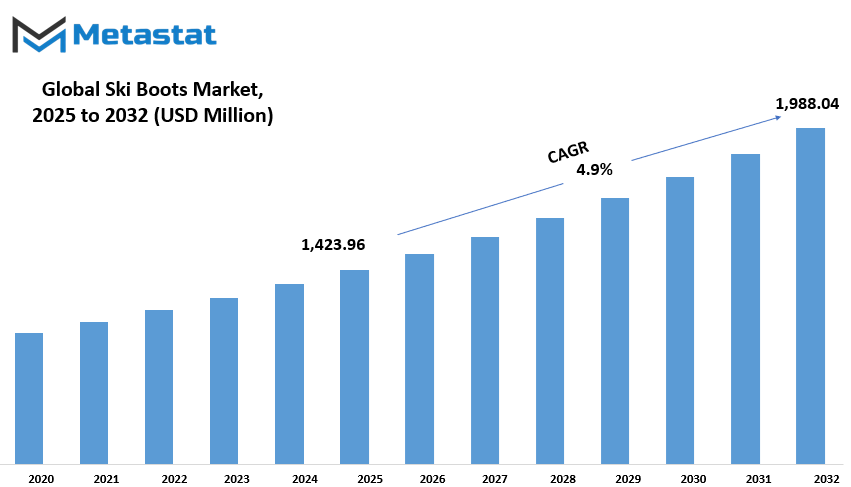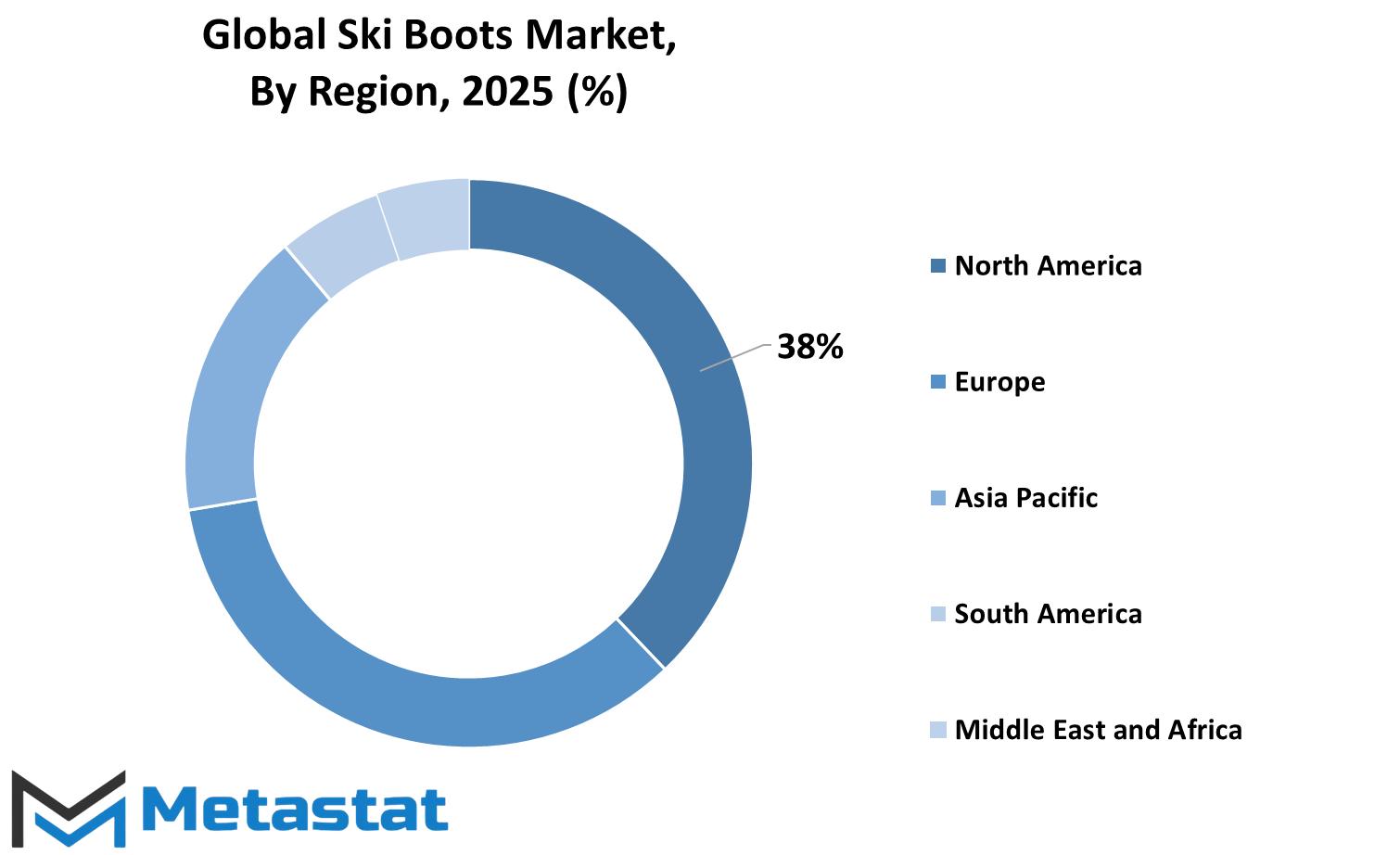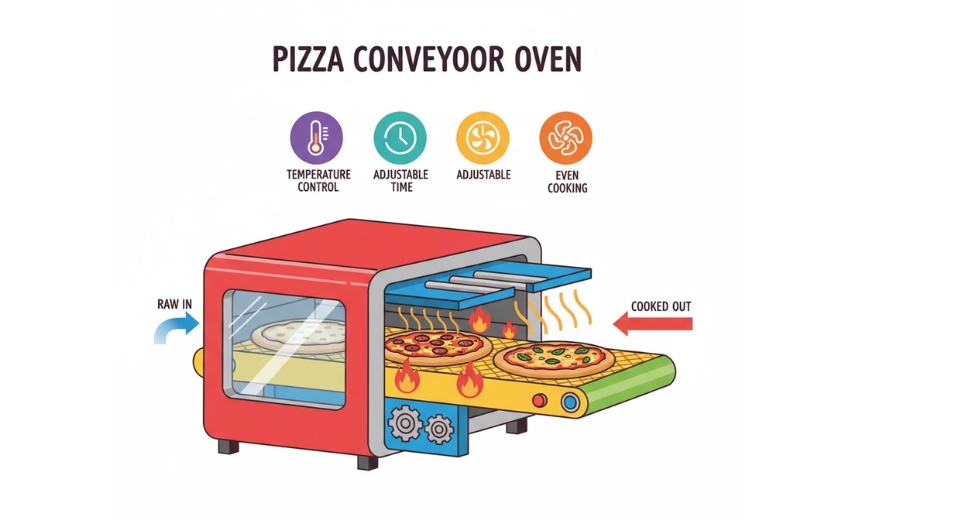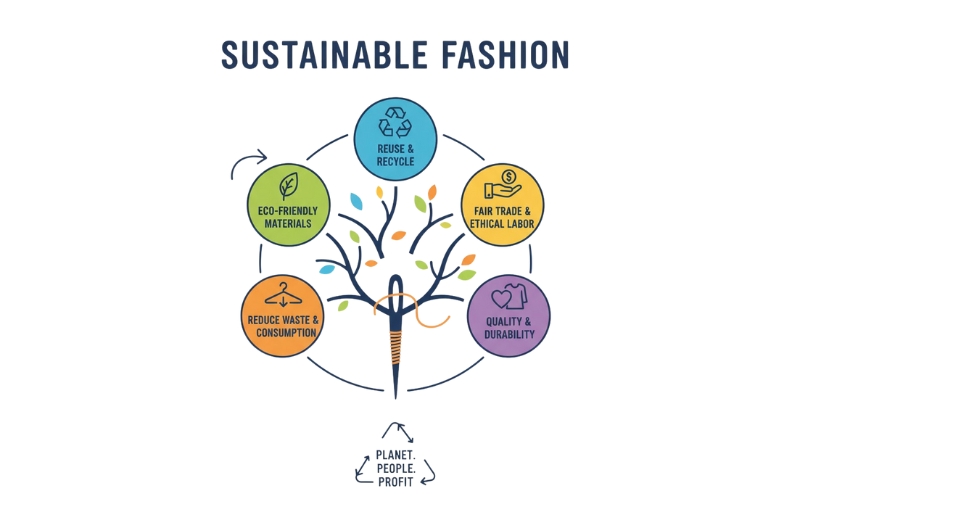MARKET OVERVIEW
The Global Ski Boots market is seen to undergo intense transformation as this market undergoes changes in preference, technology changes, and general market dynamics shifts. The changes in consumer trends, technology trends, and evolving market dynamics shape the development in ski boots designs, which remains a necessity to skiers when it comes to performance and comfort. With the increase in global interest in winter sports, the industry is preparing for a future where ski boots will not just serve traditional needs but also meet new consumer expectations and innovation.
The Global Ski Boots market, which is in the midst of rising interest in winter sports tourism, will see a personalisation and customisation push. Skiers-whether professionals or enthusiasts-will look for comfort and fit when choosing their boots. Companies will continue to spend money on more advanced materials and design techniques that can provide closer alignment with user-specific needs. Customizable features, such as adjustable flex and adaptive linings, will be standard as these allow skiers to have their boots fitted precisely to their individual foot shape and skiing style.
Materials Innovation will also mold the future of the Global Ski Boots market. Plastic and fiberglass, the two traditional materials, will be substituted by lighter composites that offer durability. They will retain more heat, become more flexible, and resist more wear and tear. Eco-friendly materials will gradually make their appearance as companies focus on sustainability compliance, reflecting environmental awareness among producers and consumers.
The second defining trend in the market will be the smart technology integration into ski boots. Devices embedded within the boots can track skiing performance, measure body temperature, and provide real-time feedback on movement and technique. This trend will be driven by the growing demand for data-driven insights to enhance athletic performance. As athletes strive for more precise control, ski boots will serve as an instrument for measuring metrics and optimizing performance during each run.
The electric ski boot, with a battery-powered heating system, will be the next revolution in comfort for skiers in colder conditions. Ski boots will keep feet warmer for longer periods and reduce discomfort for longer sessions on the slopes. The focus is going to shift toward all-day comfort in skiing, rather than just performance. Customizable heating elements in ski boots will be desirable, especially among those who frequent cold climates.
As for the Global Ski Boots market, technological advancement aside, diversification is expected within the targeted segments. Manufacturers will appeal to a wider range of skill levels, beginners up to professionals. Entry-level skis will offer features to build confidence among new skiers, making the boots more comfortable while they progress. At the same time, high-performance models will continue to take the boundaries of technology and push them up for experienced athletes demanding maximum performance.
Global distribution will also get much attention in the future of the Global Ski Boots market. Brands will also try to expand their reach into emerging markets, where winter sports are gaining popularity. In regions like Asia and South America, the number of ski resorts is growing, and the demand for ski equipment-their boots-increases with them. These markets will be of great significance and entry points, and manufacturers will shape their products according to the climate diversity and consumer preferences across regions.
As the Global Ski Boots market transforms, it shall be influenced, driven by innovating consumers along with sustainability as well as technology. In summary, skiing may be experienced today in a completely new and sophisticated way: most comfortable, custom-fit, as well as even data-informed.
Global Ski Boots market is estimated to reach $1,988.04 Million by 2032; growing at a CAGR of 4.9% from 2025 to 2032.

GROWTH FACTORS
The global ski boots market is expanding at a very high rate, especially because people now have more interest in skiing as a recreational and competitive sport. The higher the number of people getting themselves involved in skiing, the higher their requirement for comfortable, long-lasting, and high-performance ski boots. Technological advancements and new materials have also aided much in making ski boots much more comfortable and effective. These innovations provide a closer fit, greater durability, and even more favorable performance for skiers, which increases the consumer base.
There are even some challenges in the market although the trends are positive. The main problem is that premium ski boots are very pricey. Since the performance in ski boots is perfect, many casual skiers feel that these are too pricey; hence the accessibility to such a broader audience is restricted. It will be too pricey for those who are not professional athletes or regular skiers to afford high-quality ski boots. Therefore, the manufacturers have to balance the need to provide advance features with pricing that is accessible to a more significant number of consumers.
Another reason that may limit the growth of the market for ski boots could be seasonality in the skiing industry. The sport is practised during winters, which means that the demand for ski boots is mainly seasonal. It leads to uneven sales because of peaks and troughs; during the peak seasons, high demand is recorded, while during off-seasons, low demand is observed. The manufacturers of ski boots, therefore, plan their production and marketing in line with the season so that they receive steady income during the whole year.
The growing demand for green products and environmentally friendly is a bright opportunity for the ski boots market. Consumers have become more conscious of the effect that their purchases leave on the environment. Most people are demanding eco-friendly ski boots produced from sustainable materials. Such a trend towards greener products may not only provide the manufacturers with new avenues for growth but position them as market leaders in an industry that boasts sustainability.
The growing popularity of skiing and technological advancement will further fuel growth even with the challenges of market, such as the expensive price of ski boots and seasonal flow. All things considered, growth in interest towards sustainable products unlocks tremendous opportunities for the market. It is only those manufacturers who are able to find the perfect balance between performance, affordability, and sustainability who will eventually end up succeeding in this constantly evolving market.
MARKET SEGMENTATION
By Type
The global market for ski boots is a highly dynamic and comprehensive industry that fulfills the skiers' demand all over the world. This market has multiple categories, one of which depends on the particular skiing type one is performing to fulfill a purpose. One very significant segment is Alpine Ski Boots, which already holds a value of $810.26 million. Alpine skiing specifically down-ski requires comfort, as well as performance in steep, icy slopes. The demand for Alpine Ski Boots is likely high because people are getting more interested in skiing nowadays as a form of recreation and mainly because boot technology has been significantly improved to provide much control and protection for the skiers.
In addition to Alpine Ski Boots, the market offers other types including Nordic Ski Boots, Touring Ski Boots, and Freestyle Ski Boots. Nordic Ski Boots are only used in cross-country skiing. This type of skiing refers to gliding over flat terrain or gentle slopes. The boots are therefore built to be light and flexible enough to allow for the stride and push required by cross-country skiing. This segment has witnessed a steady rise in demand with the increasing interest in cross-country skiing.
Touring Ski Boots are designed for backcountry skiing, where skiers go beyond the resort boundaries. These boots have to be strong enough for rough terrains and flexible enough to allow uphill climbing and control on the downhill run. The off-piste skiing trend has also contributed to the increasing popularity of Touring Ski Boots as adventurers seek new ways to experience the slopes away from crowded areas.
Freestyle Ski Boots - another extremely important category for the market. Such shoes are developed specifically for skiers, who dedicate themselves to freestyle skiing, including jumps and some tricks. They require agility and responsiveness, being able to provide skiers with the required controllability in high-impact moves. Freestyle skiing continues to attract athletes and enthusiasts, with Freestyle Ski Boots being at the forefront of demand. Manufacturers continue to innovate to meet the needs of these adventurous skiers.
In conclusion, the global market for ski boots is diversified across different segments with various types of skiing. With Alpine Ski Boots having a firm market presence and Nordic, Touring, and Freestyle Ski Boots being quite flexible and long-lasting, this market is sure to grow along with the popularization of the sport of skiing in different parts of the world. Each one of these kinds of boots aims to maximize the performance and security of skiers so that they can have an absolute time doing their sport.
By Material
The growth of technology and the rise in demand for winter sports has increased the size of the global ski boots market. This market can be classified into several groups depending on the different factors applied during the manufacture of the boots, such as the materials. Among the commonly used materials, the most notable are Polyurethane, Pebax, and Polyamide. Each of them offers specific benefits to skiers.
Polyurethane is one of the most commonly used materials in ski boots. It is considered to be reliable, comfortable and able to ensure a good fit. Polyurethane ski boots are made very strong and therefore can withstand rugged conditions. Hence, they do not let down skiers due to any given weather condition, and they choose them for these reasons. A lot of times, people find them strong along with the aspect that they may not lose shape or flexibility with cold temperatures, and hence people like them much.
Another material commonly used in ski boot production is Pebax. This material has lightweight properties and excellent flexibility, giving skiers an edge when it comes to performance. The Pebax-based ski boots are preferred by athletes who require fast, responsive movements and increased power transfer. The material also offers superior impact resistance, making it a popular choice for high-performance skiers. This property of retaining the shape of Pebax under pressure also enhances delivery with better control, which puts it as one of the best options for those seeking accuracy and speed.
The other material, which is less common than the first two, used in the production of ski boots, is polyamide. This material is known for its strength and resistance to wear and tear. Polyamide boots are designed to help skiers have a comfortable, supportive skiing experience and are equally good for leisurely or competitive skiers. It is known to give good protection against the elements, ensuring the feet stay warm and dry through the skiing session. Moreover, the resilience of Polyamide contributes to the construction of long-lasting and robust ski boots that ensure endurance under harsh terrain conditions.
Each of the materials has their advantages, and the choice largely depends on what a skier needs. If it is a more durable option with Polyurethane, then Pebax in terms of being lighter and much more flexible; or if one is looking at a stronger option and resistance that is provided by Polyamide, ski boots would still be used by different categories of skiers. This shows the continuous improvement in the technology of ski equipment, which provides athletes with the best options in boots according to their preferences and performance levels.
By Sales Channel
The global ski boots market is appreciable owing to various reasons such as high tech advancement, growing attraction towards winter games like skiing, and higher customer interest in outside adventure. This market has been segmented into several categories; sales channels have been the prominent factor in the development of this market. Sales channel segment also includes online stores, specialty stores, and sporting goods stores. Each of these channels is important to reach different segments of customers and generate sales.
Online stores have become a hot favorite for shopping for ski boots. The easy availability of browsing from home with a wide array of choices, and often more competitive prices, has attracted quite a few customers. E-commerce sites have made it very convenient for customers to compare different brands and models, read reviews, and have the privilege of home delivery; thus, making online shopping a top preference among consumers who cherish convenience and saving time. The market for ski boots through digital platforms will probably keep on growing as most people get accustomed to online shopping.
Specialty stores focus on offering advice from experts and offer a more personalized shopping experience. The purpose of these shops is to attract enthusiasts and specialists looking for a more quality-driven product with certain specific requirements. The products available in specialty shops often come with professional fitting service, which many customers require for purchasing the items. Fit and comfort are factors that should never be taken lightly, especially for ski boots; an ill-fitting product might result in inconvenience or even cause harm. Specialty stores therefore offer a level of expertise and attention that online shopping cannot always replicate.
Sporting goods stores also remain a significant player in the ski boots market. Sporting equipment, including ski boots, is sold at these stores, and customers often prefer to shop in person. Sporting goods stores allow customers to see and feel the products firsthand, providing an opportunity to try on different pairs of boots for fit and comfort. Additionally, customers can seek advice from knowledgeable staff members, which further enhances the shopping experience.
Such key players as an online store, a specialty store, and sporting goods store hold their share within the global market of ski boots. Competition, of course, is bound to rise as customers continue to upgrade preferences for their winter sports outfits and the associated demand grows on, and ultimately helps the whole market.
By End User
This segment of the winter sports industry contains the global market for ski boots. The overall market is typically categorized based on the end-user into two huge categories: professional skiers and recreational skiers. This ensures that companies would be able to concentrate on their product development tailored to the individual needs of either of these types of users.
Professional skiers are athletes involved in high levels of competition through ski events. Their needs for ski boots are much more specific, as they require boots offering high performance, precision, and control. Advanced materials and technology are often utilized in the production of these boots to help professional skiers achieve optimal speed, agility, and stability during competition. Professional skiers' boots are usually light, durable, and offer maximum support to cope with the immense demands of competitive skiing. Manufacturers in this category focus more on the ability to customize fit and fine-tune it according to race type and skiing conditions. Such boots are not just about performance but also comfort since skiers spend long hours on the slopes. The right fit is essential in preventing discomfort or injury.
Another criterion in the process is the aspect of recreational skiing, which essentially ski for play, and will vary in several needs. Being similar to ski racing, albeit without the urgency to perform under demanding conditions as recreational skiers look more so into comfort or easy use; it is true, however. Recreation ski boot's flexibility becomes far more obvious to users on whom the activities make less and sometimes no demanding situations. These boots are made to be less stiff than the traditional versions, allowing a more relaxed feel when skiing. They also are available in multiple sizes and fits to accommodate a wider consumer, as many skiers who engage in recreational activities may not know how to hone the fit to their boot to the level that professional skiers do. With the trend for leisure skiing growing, the demand for comfortable and warm shoes, easy to wear, which balances comfort with functionality, increases as well.
Professional and Recreational Skiers constitute the global ski boots market, each differing in their needs in terms of the design and development of these products. Professional skiers require high-performance, precise and durable products while non-professional or mere users look for comfort and ease of use. Thus, the differentiation between two segments helps to understand the market dynamics and manufacturers' focus on the correct products for the right skier type.
|
Forecast Period |
2025-2032 |
|
Market Size in 2025 |
$1,423.96 million |
|
Market Size by 2032 |
$1,988.04 Million |
|
Growth Rate from 2024 to 2031 |
4.9% |
|
Base Year |
2024 |
|
Regions Covered |
North America, Europe, Asia-Pacific, South America, Middle East & Africa |
REGIONAL ANALYSIS
The global Ski Boots market is categorized geographically into five major regions: North America, Europe, Asia-Pacific, South America, and the Middle East & Africa. Each region further breaks down into specific countries or areas contributing to the market dynamics.
It consists of the U.S., Canada, and Mexico in North America. The aforementioned countries have enormous participation in the global market; however, these demands vary by country, taking into account climates, skiing culture, and tourist industries. As a major market, the United States has massive participation in skiing, and thousands of ski resorts are present; however, contributions from Canada and Mexico are far less.
Europe is another key region in the Ski Boots market, which is subdivided into countries such as the United Kingdom, Germany, France, Italy, and other European nations. These countries are well-known for their long history of skiing and snow sports, leading to a strong demand for high-quality ski boots. France and Italy, in particular, have numerous ski resorts, which boosts the demand for ski-related products.
This would cover countries in Asia and the Pacific, including India, China, Japan, South Korea, and other Asian territories. Some countries in Asia have seen the increase of skiing with the rising tourism and recreational activities during the winter season in some parts of the region, like Japan and China. Others such as India and South Korea will also play their part, because the desire to engage in snow sports has continued to increase.
South America includes the Ski Boots market for countries such as Brazil, Argentina, and other nations within this region. Though the demand is not at a high level in comparison to other regions, there are specific countries, primarily Argentina, whose ski resorts offer growing markets for ski boots along with an interest in winter sports. Brazil has a potential future in this matter as well; there is an increasingly steady population that takes up skiing as an entertaining activity.
Finally, the Middle East & Africa region consists of the GCC countries, Egypt, South Africa, and the rest of the Middle East & Africa. Many of the countries in this region do not traditionally embrace skiing, although resorts such as those in the UAE are getting more attention. The market is still in development, but growth in tourism and interest in winter sports in certain countries is pushing demand for ski equipment, including ski boots. The overall Ski Boots market continues to grow, with each region contributing based on local demand and the popularity of skiing and snow sports.

COMPETITIVE PLAYERS
The global ski boots market has experienced tremendous growth as the result of technological advancement, innovation, and growing interest in skiing as a sport and recreational activity. Major players in this market are names that have cut a strong figure globally, such as Salomon S.A.S., Rossignol Group, Fischer Sports, and Atomic Austria GmbH. All of these brands are established as top performers due to the delivery of high-performance products with a lifespan designed for every level of skier-from novices to experienced skiers.
Salomon S.A.S, the industry's leader in skiing equipment, maintains an intense level of research and development activities geared towards developing innovative performance and comfort features for their ski boots. With an emphasis on innovative designs, Salomon produces its products for perfect fit and maximum performance in the slopes. The Rossignol Group has long been known as a competitive company in ski equipment. For the precision of skiing and its comfort, this company's skis are so accurate that their performance gives them full control with response.
Other key players of the ski boot market include Fischer Sports, Atomic Austria GmbH, and Dalbello Ski Boots, which manufacture numerous models appropriate for both skiers who skid for enjoyment and those seeking performance. One such example includes Fischer Sports that concentrates on ensuring its boots bring about comfort at an optimal performance level. Atomic Austria GmbH, for instance is known for ensuring that the design of boots increases control and stability. Dalbello is identified with the desire to create high-performance boots characterized by superior power transmission and efficiency in energy consumption.
Other important players include Nordica, Blizzard Tecnica, Lange, Head Ski Boots, K2 Snow, Scarpa S.P.A., and La Sportiva Spa. These companies provide ski boots for distinct segments of this market, with entry-level boots to the expensive models that help professionals perform exceptionally well. What makes these various brands stand alone is the point of focus or niche on their products in order to provide excellence in aspects ranging from comfort to fit, strength, and reaction. For example, Lange is focused on competitive skiers and precision engineering, whereas K2 Snow has products that appeal to performance and recreational users alike.
The global ski boots market is expected to continue growing as more people engage in winter sports, and as advancements in technology lead to the development of even more comfortable and efficient ski boots. The presence of these key players ensures a competitive market that will likely offer skiers a wide range of options to choose from, regardless of their skill level or preferred skiing style.
Ski Boots Market Key Segments:
By Type
- Alpine Ski Boots
- Nordic Ski Boots
- Touring Ski Boots
- Freestyle Ski Boots
By Material
- Polyurethane
- Pebax
- Polyamide
By Sales Channel
- Online Stores
- Specialty Stores
- Sporting Goods Stores
By End User
- Professional Skiers
- Recreational Skiers
Key Global Ski Boots Industry Players
- Salomon S.A.S.
- Rossignol Group
- Fischer Sports
- Atomic Austria GmbH
- Dalbello Ski Boots
- Nordica
- Blizzard Tecnica
- Lange
- Head Ski Boots
- K2 Snow
- Scarpa S.P.A.
- La Sportiva Spa
WHAT REPORT PROVIDES
- Full in-depth analysis of the parent Industry
- Important changes in market and its dynamics
- Segmentation details of the market
- Former, on-going, and projected market analysis in terms of volume and value
- Assessment of niche industry developments
- Market share analysis
- Key strategies of major players
- Emerging segments and regional growth potential








 US: +1 3023308252
US: +1 3023308252






